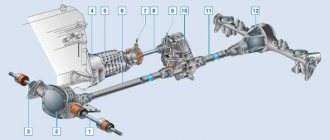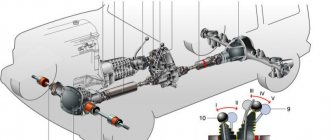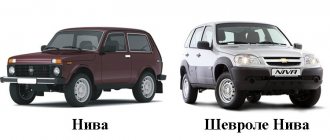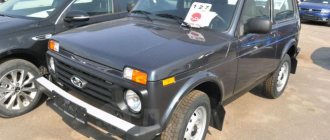Niva drive device
The chassis of the car is made on the principle of permanent all-wheel drive - torque from the power unit is transmitted to all 4 wheels. This scheme improves the performance of the car when driving in off-road conditions, while simultaneously reducing the load on transmission parts.
The Chevrolet Niva drive consists of the following components:
- Gearbox.
- Transfer case.
- A pair of drive and cardan shafts.
- Front and rear axle gearboxes.
The transfer case is designed to distribute torque between the drive axles of the vehicle. The car is equipped with a two-speed transfer case, which provides:
- stable running of the machine when driving at low speed and at high engine speeds;
- power distribution between drive axles, depending on road grip.
The differential is one of the most important elements of the transmission. Its main purpose is to distribute traction force, and, if necessary, ensure rotation of two consumers at different angular speeds. The Chevrolet Niva drive transmission has three differentials:
- One for each axle (inter-wheel) - they allow the wheels of the same axle to rotate at different speeds.
- The third (interaxle action) - transmits power from the power unit to both axles of the vehicle. It also allows the shafts to operate at different angular speeds, depending on operating conditions, which significantly improves controllability.
A pair of cardan shafts (CV joint or cross design) provide connection between the transfer case and the drive axle gearboxes. Both car shafts have the same design - they are interchangeable.
The front and rear axles transmit force from the transfer case to the drive wheels through external and internal angular velocity joints.
Rules for using differential
Usually there are two types - inter-wheel and inter-axle. The first ones block the operation of the differential installed between the wheels on one axis. The purpose of the interaxle blocking is to ensure the distribution of forces between the axles.
The Niva has three differentials, a center differential and two cross-axle differentials. But they are fundamentally different. If the inter-axle differentials are free, there are no additional devices on them, then the inter-axle differential has a forced lock. It greatly facilitates the movement of the vehicle in off-road conditions, partially giving it the capabilities of an all-terrain vehicle.
These include:
- Switching the transfer case should only be done when the car is not moving.
- You can also engage the differential while the vehicle is moving.
- You can switch to a lower gear while the car is moving.
- To ensure long-term and uninterrupted operation of the differential, it is necessary to periodically turn it on, especially in winter. This should be done once every 7 days.
In the interior of the Niva Chevrolet there are two levers between the front seats
. Using one of them you can change gears in the gearbox, and using the other you can control the transfer case.
Differential shift lever
The transfer case is based on a gearbox consisting of two stages
. The control lever comes out of it into the cabin. He can move forward or backward. At the same time, it switches on/off downshift. If the lever is moved left or right, it can turn the differential lock on/off.
Gear shift and transfer case diagram
The main component of the transfer case is the reduction gear
. If the control lever is in the rear position, then the number of transfer cases decreases and is 1.2. When the lever is in the forward position, the gear ratio increases. It will already be 2.1. When the lever is in the neutral position, the gear ratio is 0.
The differential is an integral part of the all-wheel drive mechanism in any car. It is recommended to use it only when the car is moving off-road.
NivaChevrolet has high cross-country ability in all types of off-road and mountainous terrain. Many of them can be easily overcome with a locked differential. This driving mode is recommended:
- on roads with reduced cross-country ability;
- on steep ascents and descents;
- when moving on dry (loose) sandy surfaces;
- when driving on ice, deep snow or crust.
As a conclusion, the story “How to turn on all-wheel drive on a Chevrolet Niva: diagram and video instructions” is offered. Car owners do not always know how to disable the front axle in a field, since not everyone likes the all-wheel drive of this car. By the way, it is recommended to lock the car at least once a week, especially in winter.
The principle of operation of all-wheel drive on a Chevrolet Niva
In normal mode, the Chevrolet Niva operates in high gear with the differential unlocked. Torque is transmitted from the power unit, through the gearbox and intermediate shaft, to a two-stage transfer case gearbox. A center differential is installed in the transfer case housing. It links the front and rear axles, allowing them to rotate at different speeds, depending on road conditions and direction of travel.
How does all-wheel drive work on a Niva with a locked differential?
When all-wheel drive is engaged, both cardan shafts are secured with a locking clutch. This promotes uniform transmission of traction force to both axles of the vehicle. Due to this, the vehicle's cross-country ability increases, but controllability deteriorates.
Advice: It is not recommended to use the lock mode on roads with good grip, as this will lead to accelerated tire wear, increased load on transmission parts and components, and will also increase fuel consumption.
Power steering
The car is equipped with power steering, which significantly reduces the force on the steering wheel. If the power steering is not functioning (for example, when towing a vehicle with the engine not running), you can still steer the vehicle, but you will need to apply significantly more force to the steering wheel to do so. In extreme positions of the steering wheel, functional noise is allowed.
Warning
- Do not coast with the engine not running! In this case, the power steering does not work, putting you and other road users at risk.
- It is not allowed to hold the steering wheel in extreme positions for a long time.
Transmission of Chevrolet Niva and Lada 4x4: what is the difference
The first thing that catches the eye of the average user is that the Lada’s transmission is controlled by two levers, while the Chevrolet Niva has only one, not counting the gearbox control lever. This is due to the fact that Chevrolet’s upshift and downshift ranges, as well as the center differential lock, are implemented using a single-lever design. In addition, the Niva's front axle gearbox is not attached directly to the engine cylinder block, and the transfer case has three mounting points, unlike the Lada, which has two.
Nevertheless, both cars are absolutely identical in transmission design, have one engine for two, but due to the transfer case set back, the Niva’s intermediate shaft is longer than that of the Lada 4x4 by exactly 250 mm. Moreover, both cardan shafts driving the front and rear axles are completely interchangeable.
Chevrolet Niva
Any Niva, even a Chevrolet, has two additional transmission options in its arsenal. The driver is free to decide whether to block the center differential or not, and can choose one of two rows of the transfer case. However, the more options there are to choose from, the greater the chance of making mistakes.
TOGETHER OR AWAY?
For example, a very common recommendation is to always turn on the center lock on icy and snowy roads. Many people believe that it improves the car's behavior on slippery roads. Let's check by measuring the car's acceleration on ice and snow, the passage of an ice circle and the speed of successfully performing a changeover on compacted snow. Skidding braking was excluded, since the condition of the center differential does not affect the braking distance. At the same time, we assessed the ease of driving and maneuverability in deep snowdrifts.
The test was held by Chevrolet Niva on Nokian HKPL R velcro tires with dimensions 205/70R15. An extract from the grade book is in the tables below.
Design and diagram of the Chevrolet Niva transmission
The Chevrolet Niva transmission, in terms of operating principle and architecture, completely replicates the donor car, the VAZ 2121 and its modification, the VAZ 21213. This means that the drive is carried out to all four wheels constantly, without the possibility of disabling the front axle. The design provides a number of reduction gears, as well as a manually lockable center differential.
The main elements of the transmission are as follows:
- dry single-plate clutch;
- five-speed gearbox;
- intermediate shaft;
- transfer case;
- 2 cardan shafts driving the front and rear axles;
- front split axle with a gearbox separately mounted on the load-bearing frame;
- continuous, solid rear axle with integrated gearbox and differential, as in classic Tolyatti models.
The transmission structure is shown in the drawing and it is no different from most SUVs with permanent all-wheel drive, as well as the operating principle.
Torque is transmitted from the engine crankshaft through a dry single-plate clutch to the gearbox input shaft. Next, the torque enters through the reduction gears in the box and is transmitted through the output shaft to the transfer case, where it is evenly distributed between the drive axles. The stock Chevrolet Niva does not have a power take-off shaft, which can be used to transmit rotation to the winch.
We help with all our wheels
How to enable all-wheel drive on a Chevrolet Niva? You can block the center differential of the Chevy Niva both when the car is stationary and while driving.
This is done with the clutch pedal depressed using the transfer case control lever, which is located behind the large gear selector. How to disable the front axle on a field? Let's explain. When the lever is in the neutral position, you need to pull it towards the driver. How does all-wheel drive work on a Subaru?
How does full work? Is it possible to turn it off in the field? It has permanent all-wheel drive for everything, just like on the go. If you then press in the opposite direction, a lower gear will be engaged with a center differential lock and a gear ratio of 2.1. If you pull it towards you, a lower gear is activated (gear ratio 1.2).
When the lever is in this position, the corresponding yellow pictogram lights up on the dashboard. Doesn't know how to turn off folding mirrors. What do I need and change the Outlander to something else. If you cannot follow these instructions, try repeating the procedure while driving the vehicle.
Gearbox and clutch Niva Chevrolet
The Niva has virtually the same VAZ gearbox, but with minor changes designed to increase the durability of the unit. Firstly, this is the replacement of the VAZ rear bearings of the primary shafts and intermediate bearings on the secondary shafts with similar, but sealed types. This eliminates bearing malfunctions associated with contamination and premature wear. Secondly, the gear shift control drive has been changed. It is easy to notice that in a Chevrolet the gearbox control lever is closer to the driver, which makes control more convenient. This was achieved through the use of an extension with a 250 mm horizontal rod. Gear ratios remain the same, as does the gear shift pattern.
The clutch device in the Chevrolet Niva transmission has undergone some changes and received a number of improvements and more progressive parts from front-wheel drive VAZ cars.
Features and malfunctions of the transfer case
The Chevrolet Niva transfer case not only moved back by 250 mm, but also changed the installation angle by 4 degrees. Chevrolet engineers calculated that this angle would be optimal for the operation of driveshaft joints. The design of the transfer case uses small-module, low-noise gears, so the howling of the transfer case, as on the old Niva, is now completely eliminated.
Another common malfunction of the transfer case on old Nivas was vibration. On Chevrolet, this issue has been practically resolved by installing new pillows and the appearance of a third attachment point. This will eliminate not only operational vibrations and noise, but also the likelihood of incorrect installation of the transfer case after repair, prevention or troubleshooting.
There is another malfunction that few people think about, however, this problem is related to the resource and endurance of constant velocity joints. The fact is that a cermet valve is installed directly under the CV joint boot mounting clamp. Its task is to compensate for excess pressure inside the cover, thereby protecting it from rupture, and the CV joint itself from water and dirt. If you monitor the performance of the cermet valve during repairs or replacement of hinges, the boot will last a long time and will reliably protect the CV joint.
Even such a complex system as the Chevrolet Niva transmission can be succinctly described in an accessible way. Each owner is required to know the basic principles of operation of the systems of his car.
How to remove the front axle gearbox of a VAZ-21213 car
Before removing, clean the gearbox from dirt. We install the dismantled gearbox on a workbench.
Using a 10mm spanner, unscrew the eight nuts securing the front cover to the gearbox housing.
Using a 10mm socket, unscrew the bolt securing the locking plate of the left differential box bearing cover...
...and remove the plate. Similarly, remove the locking plate of the right cover.
Using a 19mm socket, unscrew the four nuts securing the differential box bearing caps.
Removing the front axle gearbox
We carry out the work on a lift or inspection ditch.
Drain the oil from the front axle gearbox (see Changing the oil in the front axle gearbox). We disconnect the driveshaft from the front axle gearbox (see Removing the driveshaft). We dismantle the right drive (see Removing the front wheel drives). Disconnect the lower left ball joint from the lever (see Removing the lower ball joint). Remove the left front suspension brace (see Removing the brace).
Using a 13 mm spanner, unscrew the three nuts securing the bearing cover of the left drive inner joint housing to the front axle gearbox.
Use a spatula to pry off the bearing cover.
...and, pulling the steering knuckle with the drive to the left, we remove the splined part of the housing of the internal drive joint from the hole in the gearbox housing.
We move the housing of the internal drive joint back.
to the cylinder block bracket...
...and to the left engine mount bracket.
Having removed the stop from under the gearbox,...
Install the gearbox in reverse order.
The front axle structure is shown in Fig. 3-81. To distinguish it, a mark in the form of the number “13” is applied to the gearbox housing with paint.
1 — mud deflector; 2 — lower cover of the gearbox housing; 3 — drive gear bearings; 4 — differential housing; 5 — drain plug; 6 — filler and control hole plug; 7 — bearing of the internal hinge housing; 8 — oil seal; 9 — housing of the internal wheel drive hinge; 10 - spring washer;
11 — retaining ring; 12 — bearing cover; 13 — adjusting nut; 14 — differential box bearing; 15 — bearing cover; 16 — cover fastening bolt; 17 — support washer; 18 — axle gear; 19 — satellite; 20 — gear housing; 21 — breather; 22 — front axle mounting bracket;
The front axle gearbox of the Niva VAZ-21213 car is removed for repair work, when it is necessary to correct the defects that we discussed in the article - “Features of the front axle of the VAZ-21213”.
The work must be done on a lift or inspection pit.
We prepare the car for work.
We drain the oil from the front axle crankcase (see the article - “Changing the front axle oil”).
We dismantle the driveshaft (see the article - “Removing driveshafts”)
We remove the right-hand drive (article – “Removing and installing front wheel drives”)
— hang out and remove the left front wheel;
— unscrew the adjusting nut of the front hub bearings;
1. Using a 22mm spanner, unscrew the nut securing the ball joint to the steering knuckle.
2. Place the stop under the lower arm and use a 13mm wrench to unscrew the 3 nuts on the bolts securing the ball joint to the lower arm, holding the bolts with a second wrench.
Chevrolet Niva transmission device
Transmission is a purely technical concept and does not relate exclusively to a car. Literally, it is a power transmission that ensures the integral functioning of the mechanisms. Applicable to a specific car model, we can conclude that the Chevrolet Niva transmission is represented by mechanisms that implement the transfer of torque from the engine to the wheels with the possibility of changing it. We have another video on the topic of Chevrolet Niva transmission.
The VAZ-2123 transmission includes the following units:
- Variable gearbox;
- Transfer case;
- Intermediate shaft;
- Drive and cardan shafts;
- Rear axle;
- Front axle.
The transmission provides permanent drive. This means that it is impossible to disable the front axle of a Chevrolet Niva. This scheme increases fuel consumption and also reduces noise and vibration insulation characteristics, but is considered the most optimal in off-road conditions.
The torque transmission diagram can be represented as follows: engine – clutch – gearbox – intermediate shaft – transfer case. The drive is transmitted to the axles via cardan shafts. The Chevrolet Niva transfer case has a center differential. In operation, it provides different angular displacement of the front and rear wheels. The differential lock allows you to equalize the angular speeds of rotation of both cardans. (you can see it more clearly in the video)
Important. The operation of the transmission with a locked differential is intended only for overcoming obstacles. Driving along a straight section of the road at high speed leads not only to excessive vibration of the car, but also to increased loads on the transfer case, which can cause its early failure.
The transfer case can operate in two modes. When you turn on the reduction mode, the torque increases. The features that the Chevrolet Niva gearbox has in conjunction with the transfer case allow you to control the torque and engage the center differential lock with one lever, and not two, like the predecessor VAZ-2121.
Disabling the bridge
Some people have a passion for innovations in cars, including craftsmen who can change the front axle; Niva 2121 is the most common victim of this experiment. Disabling the front axle is done for many reasons, for example, to reduce tire wear, but the miraculousness of this method is questionable.
Modernizing important elements has always been a very expensive pleasure. An important element is the front axle - the Niva can be equipped with the ability to disable it for an amount slightly less than seven thousand rubles. It is noteworthy that the amount paid for the purchase and installation of a shutdown may never be recouped - fuel consumption decreases slightly, and the Niva is rarely driven on a dry and level road.
Is it necessary to modify the transfer case of a VAZ 4×4 Niva Cheviniva with the 4x2 mode (disable all-wheel drive), leaving only
The correct sequence for engaging the rollover lock is given in the owner's manual for that vehicle. It states that such blocking must be carried out in advance, while the car is moving along a section of the road with a hard surface. How does all-wheel drive work in a Duster? How to replace a CV joint on a Chevrolet Niva?
What is a CV joint? How do you know when it's time to change it? The action must be performed when changing the steering wheel position. To prevent breakdowns and damage to differential parts, locking is prohibited during slipping or when the wheels (wheels) are sliding. The mode is switched using the same lever.
If the lock does not engage using this method, do not use excessive force. Chevrolet Niva forum all-wheel drive implemented in there is not yet a viscous coupling, but as on. Removing the back seat of a Chevrolet Cruze. How to remove the back seat from a Chevrolet car. Just repeat the entire sequence of actions from the beginning.
Switching to a lower gear is also allowed without stopping the Niva completely, but this can only be done by experienced drivers. The fact is that the transfer case, unlike the gearbox, does not have synchronizers installed. Changing from a lower gear to a higher gear while the car is moving is undesirable, although it is allowed in extreme cases.
It is not recommended to keep the center differential of the wheels in locked mode at all times, especially when driving on asphalt roads, as this will not only lead to increased fuel consumption by the vehicle and poor handling, but also to the breakdown of expensive transmission components.
Transmission
The Chevrolet Niva gearbox has no structural differences compared to the Lada 4x4 box, and they are identical in design. The difference can only be noticed in the mounting and length of the gear shift drive. Another important feature is the presence of 5th gear.
The main parameter of the gearbox is the gear ratio. By trivial definition, this is the ratio of the number of teeth of the driven shaft to the number of teeth of the drive shaft. Naturally, we talk about the gear ratio when there is actually a transfer of torque from one shaft to another. If the specified parameter is greater than 1, then such a mechanism works to increase torque. The gear ratio for IV gear is 1, and for V – 0.82. That is, in V gear there will be an increase in the number of revolutions of the secondary shaft with a parallel decrease in torque. It is more convenient to imagine the value of the gear ratio using the sprockets of a high-speed bicycle.
Transfer case
The transfer case and differential control lever (multiplier) allows you to combine one of two modes with turning on or off the center lock. Together with neutral, there are 5 lever positions.
- Neutral position. There is no engagement in the main pair. The car cannot move.
- Differential unlocked, reduction disabled. Essentially, this is normal mode for everyday driving. The distribution of the moment of force occurs in a ratio of 1:2.
- Differential locked, reduction disabled. The distribution of the moment of force between the axles occurs in equal shares, but due to the operation of the cross-axle differential, the force on each wheel depends on the road surface.
- Differential is unlocked and reduction is engaged. The torque has been increased, but its distribution between the axles is 1:2.
- Differential locked, reduction enabled. Bridges work in a rigid connection. The car has the most increased cross-country ability.
Resource of transmission elements
With proper maintenance, all transmission elements have service lives that comply with the regulations. The existing stereotype about unreliability is not confirmed either documentary or practically. Until now, the Chevrolet Niva remains one of the most popular cars on the market. The owners claim that the car is taking care of its 200,000 km, which the plant lays down as a resource. This means that the transmission resource is determined by the manufacturer and cannot be less than 200,000 km.
Once again, emphasis should be placed on timely maintenance as a guarantee of flawless operation of the system.
There was a breakdown
The front axle (Niva) often requires replacement, the price of which sometimes reaches 20,000 rubles, for those people who are constantly trying to improve their car or reduce its consumption. The actions of amateurs lead to increased wear of one or another bridge, and sometimes both at once. However, the bridge does not always fail due to human intervention, because no one has canceled simple breakdowns and wear of parts.
It's okay if you've never seen the front axle, Niva will forgive you for that. The sound will immediately let you know about a breakdown - increased noise, squealing and squeaking will be difficult to miss. Another common problem is oil leakage, but this problem can easily be identified during a technical inspection. It is easy to understand that noise occurs when there is poor engagement, wear of bearings and gears, as well as physical damage to the bridge, which is extremely unlikely, but still possible.










